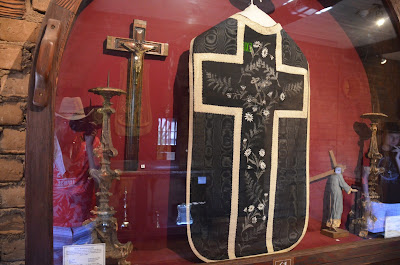Today is the Feast of St. Gabriel the Archangel. On feastdays in Lent, more often the Mass of the Lenten feria is said with only a commemoration of the feast - unlike the other seasons in the Church's liturgical year. Today is also the day before the Feast of the Annunciation - which commemorates the announcement to Mary that she would conceive and give birth to the Lord. March 25th is the most important day in human history 3 times over!
The following is taken from Butler's Lives of the Saints for today:
By a decree of the Congregation of Sacred Rites dated October 26, 1921, issued by command of Pope Benedict XV, it was directed that the feast of St Gabriel the Archangel should be kept in future as a greater double on March 24 throughout the Western church.
As the question of the liturgical celebration of festivals in honour of the great archangels will be more naturally treated in connection with the older feast of St Michael on September 29, it will be sufficient here to point out that according to Daniel (ix 21) it was Gabriel who announced to the prophet the time of the coming of the Messiah, that it was he again who appeared to Zachary "standing on the right side of the altar of incense" (Luke i 10 and 19) to make known the future birth of the Precursor, and finally that it was he who as God's ambassador was sent to Mary at Nazareth (Luke i 26) to proclaim the mystery of the Incarnation.
It was therefore very appropriate that Gabriel should be honoured on this day which immediately precedes the feast of the Annunciation of the Blessed Virgin. There is abundant archaeological evidence that the cultus of St Gabriel is in no sense a novelty.
An ancient chapel close beside the Appian Way, rescued from oblivion by Armellini, preserves the remains of a fresco in which the prominence given to the figure of the archangel, his name being written underneath, strongly suggests that he was at one time honoured in that chapel as principal patron. There are also many representations of Gabriel in the early Christian art both of East and West which make it plain that his connection with the sublime mystery of the Incarnation was remembered by the faithful in ages long anterior to the devotional revival of the thirteenth century.
This messenger is the appropriate patron-saint of postal, telegraph and telephone workers. See the Acta Apostolicae Sedis, vol. xiii (1921), and the note to Michael the Archangel on September 29.It was St. Gabriel, according to some, who also announced the birth of Jesus to the shepherds. And according to Dom Gueranger in his "Liturgical Year," was the angel that comforted our Lord in the Garden before the beginning of His Passion: "Lastly, when Jesus is suffering His agony in the garden of Gethsemani, an angel appears to Him, not merely as a witness of His sufferings, but that he might strengthen Him under the fear His human nature felt at the thought of the chalice of the Passion He was about to drink. Who is this angel? It is Gabriel, as we learn not only from the writings of several holy and learned authors, but also from a hymn which the Holy See has permitted to be used in the liturgy."
More Reading for Today: What are Angels? A Summary & Exposition on Angels for Catholics
Gabriel, angel of light, and strength of God!
whom our Emmanuel selected from the rest of the heavenly princes,
that thou shouldst expound unto Daniel
the mystery of the savage goat.
Thou didst joyfully hasten to the prophet as he prayed,
and didst tell him of the sacred weeks,
which were to give us the birth of the King of heaven,
and enrich us with plenteous joy.
’Tis thou didst bring to the parents of the Baptist
the wondrous and gladsome tidings that Elizabeth,
though barren, and Zachary,
though old, should have a son.
What the prophets had foretold from the beginning of the world,
this thou didst announce in all the fulness
of the mystery to the holy virgin,
telling her that she was to be the true Mother of God.
Thou, fair spirit, didst fill the Bethlehem shepherds with joy,
when thou didst tell them the heavenly tidings;
and with thee a host of angels sang
the praises of the newborn God.
As Jesus was in prayer on that last night,
when a bloody sweat bathed his limbs,
thou didst leave heaven to be near him,
and offer him the chalice that his Father willed him to drink.
O blessed Trinity!
strengthen Catholic hearts with the heavenly gift of faith.
Give us grace,
as we to thee give glory for ever.
Amen.
Collect:
O God, from among all the angels You chose the archangel Gabriel as the messenger of the mystery of Your Incarnation. May his intercession in heaven help us as we celebrate his feast on earth; who lives and rules with God the Father, in the unity of the Holy Spirit, one God forever and ever.

























